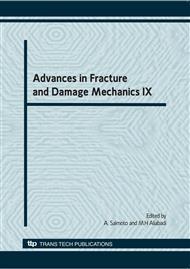p.489
p.493
p.497
p.501
p.505
p.509
p.513
p.517
p.521
Molecular Dynamics Simulations of Pre-Crack Effects on Deformation and Failure Mechanisms for Pure Aluminum
Abstract:
Micro-cracks which seriously affect the strength of metal materials always exist in metal or alloys during the manufacturing process. In order to investigate the pre-crack effects on deformation and failure mechanisms for pure aluminum at atomic scale, the plastic deformation processes of pure aluminum with face-centered cubic (fcc) crystal structure around the pre-crack tips at atomic scale were examined by means of molecular dynamics (MD) method. The Modified Embedded Atom Method (MEAM) potential was used to describe the interaction among atoms of pure aluminum. The crack propagation and failure processes for fcc structure were observed near the pre-crack tip zone. The calculation results reveal that the pre-crack blunting occurred at first, then the dislocation emitted at the pre-crack boundary and moved along with the specific direction obviously, eventually, cracks propagated along the crystallographic direction family of <110>. By means of VMD software, the graphic pictures of dislocation movement and crack propagation were obtained under different load conditions. The results and methodology given in this study are very significant for understanding more about plastic deformation and destruction at atomic scale for pure Aluminum with fcc structure.
Info:
Periodical:
Pages:
505-508
Citation:
Online since:
November 2010
Authors:
Keywords:
Price:
Сopyright:
© 2011 Trans Tech Publications Ltd. All Rights Reserved
Share:
Citation:


